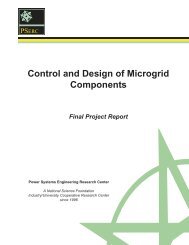Development and Evaluation of System Restoration Strategies from ...
Development and Evaluation of System Restoration Strategies from ...
Development and Evaluation of System Restoration Strategies from ...
You also want an ePaper? Increase the reach of your titles
YUMPU automatically turns print PDFs into web optimized ePapers that Google loves.
interval. Optimality is achieved for each step individually. The algorithm was tested<br />
using PECO data.<br />
Second, we derived a new formulation <strong>of</strong> the generator start-up sequencing problem as a<br />
Mixed Integer Linear Programming (MILP). The linear formulation leads to a global<br />
optimal solution that outperforms other heuristic or enumerative techniques in both<br />
quality <strong>of</strong> solution <strong>and</strong> computational speed. The IEEE 39-Bus system was used for<br />
validation <strong>of</strong> the generation capability optimization. The simulation results demonstrated<br />
the high efficiency <strong>of</strong> the MILP-based generator start-up sequencing algorithm.<br />
Part II. Transmission <strong>System</strong> <strong>Restoration</strong> with Constraints Checking<br />
(work done at Arizona State University)<br />
A Constraint Checking Module is needed for a restoration computer tool. After a system<br />
blackout, parallel restoration <strong>of</strong> subsections <strong>of</strong> the system is an efficient way to speed up<br />
restoration. The system sectionalizing strategy determines the proper splitting point to<br />
sectionalize the entire blackout area into several subsystems. Parallel restoration can be<br />
carried out in each subsystem. For a large scale power system, this system sectionalizing<br />
problem is complicated due to black start <strong>and</strong> generation/load balance constraints. For<br />
system sectionalizing, we used an ordered binary decision diagram method that quickly<br />
finds the splitting points. Simulation results on the IEEE 39-Bus system showed that the<br />
method successfully sectionalized the system in a way that satisfied the two constraints.<br />
The method was implemented in the Constraint Checking Module.<br />
A Transmission Path Search Module enabled optimization <strong>of</strong> the restoration sequence<br />
for linking the subsystems into a larger system, thereby gradually reducing the number <strong>of</strong><br />
subsystems to zero. An objective transmission restoration path selection procedure, with<br />
the option to check constraints, may be better able to h<strong>and</strong>le unexpected system changes<br />
during restoration <strong>and</strong> still provide the information needed by system operators for<br />
completing the restoration process. We developed a path selection approach that used<br />
power transfer distribution factors (PTDFs) for large-scale power systems. Two types <strong>of</strong><br />
restoration performance indices were computed. They included all possible restoration<br />
paths. The computed indices were ranked, then PTDFs <strong>and</strong> weighting factors were used<br />
to determine the ordered list <strong>of</strong> restoration paths. This method enabled load to be picked<br />
up by lightly-loaded lines or by relieving stress on heavily-loaded lines. Successful test<br />
results <strong>of</strong> the Transmission Path Search <strong>and</strong> Constraint Checking Modules were<br />
obtained by using the IEEE 39-Bus system <strong>and</strong> by doing a realistic restoration exercise<br />
for the western region <strong>of</strong> Entergy’s transmission system.<br />
Part III. Automated <strong>Restoration</strong> <strong>of</strong> Power Distribution <strong>System</strong>s<br />
(work done at Arizona State University <strong>and</strong> University <strong>of</strong> Tennessee)<br />
During a system-wide restoration process, distribution system restoration is a critical task<br />
to help reduce economic losses <strong>and</strong> public dissatisfaction brought by a service<br />
interruption, especially in restructured competitive electricity markets. In this project we<br />
showed that fast, practical computational tools can be used to provide guidance for a<br />
distribution system restoration process that adapts to real-time system conditions. The<br />
tool can support decisions by operators during the restoration process by providing<br />
iii
















